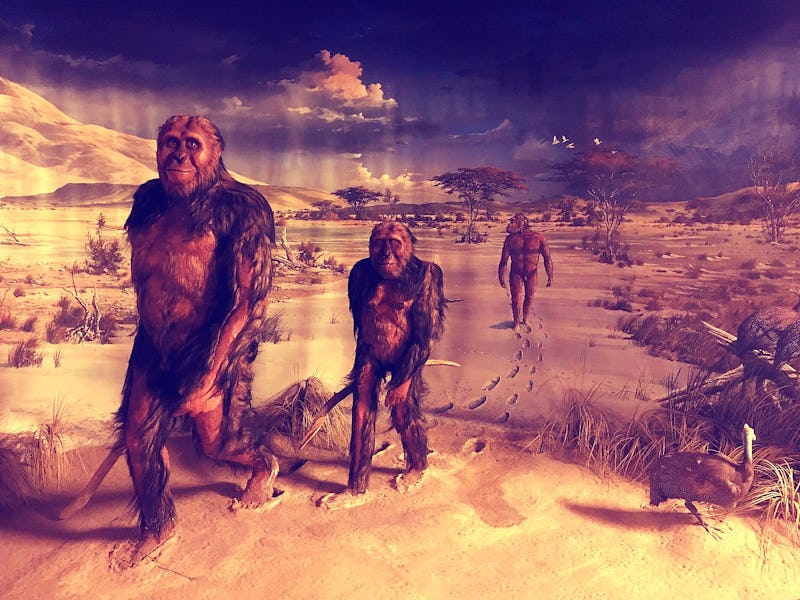Evolution of Walking Upright Linked to Ancient Supernova in Weird New Theory
A massive star explosion 2.6 million years ago may be the reason we walk on two feet.

Carl Sagan famously said, “We are made of star stuff.” For modern humans, this may be true in a very unexpected way. Research published Tuesday in The Journal of Geology suggests that stars are what nudged our ancient ancestors to evolve to walk on two feet. It posits that supernovae that occurred millions of years ago led to an increase in wildfires, forcing early humans out of the trees and onto the plains of Africa.
The paper’s authors argue, using geological data, that the cosmic rays emanating from one or more supernovae reached Earth about 2.6 million years ago, setting off a catastrophic chain of events that resulted in our ancient hominin ancestors transitioning to walking upright on two legs.
In the paper, study co-authors Adrian Melott, Ph.D., a professor emeritus of physics and astronomy at The University of Kansas, and Brian Thomas, Ph.D., a professor of physics and astronomy at Washburn University, build their case by connecting the dots among past studies on cosmic rays, atmospheric science, and anthropology.
The Hypothesis
The supernovae in question, they hypothesize, came from about 50 parsecs — 163 light years — away from our planet. When the cosmic rays radiating out from them reached Earth, they set off a series of electron avalanches in the planet’s atmosphere. This, in turn, led to an abundance of lightning storms, and these storms touched off forest fires in northeastern Africa, where human ancestors were living in the trees.
As the hypothesis goes, not only did these fires abruptly convert the forests of northeastern Africa to savannas, but the environmental pressure probably killed off individuals who couldn’t adapt to living in the plains instead of the forests.
In short, this hypothesis explains that stellar explosions eventually nudged the evolution of early humans who walked upright on two legs by killing off those who couldn’t.
The Geological Evidence
This idea may sound farfetched, but there is evidence to back up the occurrence of supernova-ignited forest fires. As Melott and Thomas wrote in a 2016 study, seabed sediment layers of the isotope iron-60 support the hypothesis, as it’s well established that supernovae emit a wide range of metals. Plus, layers of carbon and soot in sedimentary rock around the same time period further reinforce the connection between cosmic rays and forest fires.
In addition to the ancient seabed layers, a sort of natural laboratory demonstrated that atmospheric electrons could indeed spark forest fires. Aragats Mountain in Armenia, the authors write, provided a practical setting for testing the idea that space radiation could set off electron cascades leading to lightning. Since the cloud cover around Aragats Mountain hangs low enough for Earth-based scientists to measure, a 2017 study showed that cosmic radiation would theoretically lead to lightning.
“They found a number of electron avalanches of duration less than a microsecond that were terminated by nearby lightning flashes,” they write. “This is a smoking gun that makes this a compelling theory, which we will take as our working model.”
Extensive research on ancient human ancestors in Africa also put the evolution of bipedal walking around the same time that the sediments suggest cosmic rays were affecting Earth’s atmosphere.
For instance, anatomical examinations of Australopithecus afarensis, a species that lived around 3.2 million years ago and includes the famous Lucy, suggests it climbed trees and walked upright.
Evolution is a gradual process, so widespread forest fires wouldn’t lead to an immediate shift in early hominins, but if supernova-triggered fires started wiping out forests and replacing them with savannas, then A. afarensis was evolving right on schedule.
“The conversion from woodland to savanna has long been held to be a central factor in the evolution of hominins to bipedalism, although more recent thinking tends to view it as a contributing factor,” the authors write. “Thus, it is possible that nearby [supernovae] played a role in the evolution of humans.”
Abstract: Multiple lines of evidence point to one or more moderately nearby supernovae, with the strongest signal at ∼2.6 Ma. We build on previous work to argue for the likelihood of cosmic ray ionization of the atmosphere and electron cascades leading to more frequent lightning and therefore an increase in nitrate deposition and wildfires. The potential exists for a large increase in the prehuman nitrate flux onto the surface, which has previously been argued to lead to CO2 drawdown and cooling of the climate. Evidence for increased wildfires exists in an increase in soot and carbon deposits over the relevant period. The wildfires would have contributed to the transition from forest to savanna in northeast Africa, long argued to have been a factor in the evolution of hominin bipedalism.